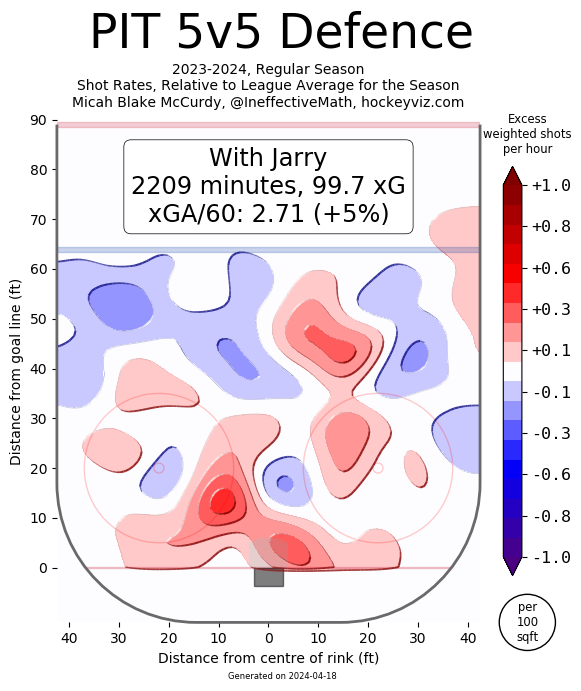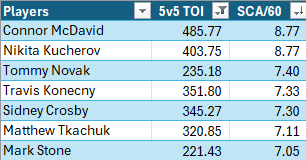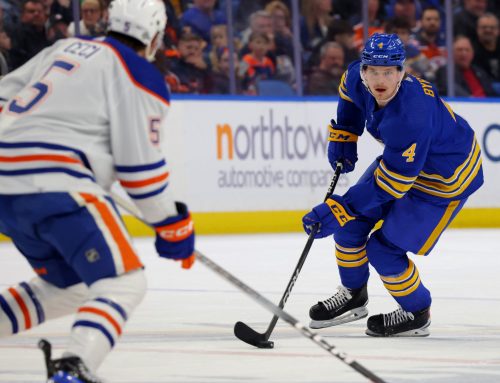It was a very wild back and forth Game 3 between New York and Florida that needed some overtime to decide it.
The Panthers got out an early lead thanks to a Sam Reinhart power play goal but Alexis Lafreniere replied five minutes later to tie the game, and it was a beautiful backhand:
Barclay Goodrow and Reinhart (another PPG) scored later in the frame to give us a 2-2 game.
Lafrenière and Goodrow tallied three minutes part, the latter while short-handed, to give the Rangers a 4-2 lead heading into the third. However, Aleksander Barkov and Gustav Forsling scored less than two minutes apart to tie things up 4-4, which is where things stood heading to OT.
Lafrenière's second goal was even prettier than the first:
These playoffs have really put everyone onto how good Lafrenière has been this season. He is starting to fulfill that lofty potential and it'll be fun to see where he lands ADP-wise in September because he's still no closer to earning a top PP role.
It was also a game that made it blindingly obvious just how much the Rangers should be playing Adam Fox right now, given how hurt he is.
Regardless, Alex Wennberg deflected home a Ryan Lindgren shot over five minutes into the extra frame to give the Rangers the 5-4 win and a 2-1 series lead. It was one of those games where the Rangers probably didn't deserve to win, but with two wins separating them from a Stanley Cup appearance, deserve's got nothing to do with it now.
*
There are just three teams left in my offseason reviews of the 16 non-playoff squads and today's team is the Pittsburgh Penguins, a team that is at a franchise-changing moment. We have already gone over the San Jose Sharks, the Chicago Blackhawks, the Anaheim Ducks, the Columbus Blue Jackets, the Montreal Canadiens, the Arizona Coyotes (now in Utah), the Ottawa Senators, the Seattle Kraken, the Calgary Flames, the New Jersey Devils, the Buffalo Sabres, the Philadelphia Flyers, and the Minnesota Wild.
Data from Natural Stat Trick, Evolving Hockey, HockeyViz, and Frozen Tools with salary cap data from Cap Friendly. Any tracking data is from AllThreeZones unless otherwise noted.
What Went Wrong
While Pittsburgh's power play problems weren't nearly as bad as their state rivals in Philadelphia, the Penguins still struggled mightily with the man advantage. They finished 30th in the league by goals per 60 minutes with the man advantage (though that was still 27% higher than the Flyers) and were 1 of 5 teams with 40-or-fewer power play goals. That led to Sidney Crosby having just 23 power play points, or his lowest total in any season where he's played at least 60 games. It also led to just 18 power play points for Evgeni Malkin (he had 36 the season before), 13 power play points in 50 games for Jake Guentzel (about 21 in a full season), and 17 power play points for Erik Karlsson (he had 27 the year before on an awful San Jose roster). The team didn't have an elite power play in 2022-23, but their goal rate was 13th in the league and in line with teams like New Jersey and Florida. Had they just repeated that performance, or even had just a 10% decline, they would have made the playoffs, and their top skaters would have had much better fantasy seasons.
The weird part is they had no trouble generating shots around the net, they just couldn't finish:

To put a point on that finishing problem: Guentzel and Malkin combined for 10 power play goals on 119 shots, or 8.4% shooting. In other words, Guentzel and Malkin were less efficient at scoring on the power play than Brett Howden was at 5-on-5. Just let that bounce around your brain for a minute.
Relatedly, it wasn't a good fantasy season for Malkin. His 0.82 points per game was a career-low mark and it was related to his assist totals. He managed 0.49 assists per game, which was also a career-low mark. This is where things get interesting.
Malkin managed 1.2 assists per 60 minutes at 5-on-5, which is the worst mark of his career for any season where he played at least 60 games. He also registered a point on just 73.7% of goals scored with him on the ice, also a career-low. However, the team shot 9.6% with him on the ice, which was a four-year high, and the same can be said of the goals-for rate. So, the team scored more with him on the ice at 5-on-5 than any of the prior three seasons, but he had career-lows in assist rate and goal participation. Pardon?
The key could be found in the team's transition tracking data. This past season, Malkin was responsible for fewer than 18 entries per 60 minutes at 5-on-5. His two most-common line mates were Reilly Smith and Rickard Rakell. Those three players had virtually identical rates of zone entries:

They differed on what they did with the entries, but Rakell had solid-but-not-good carry-in numbers and Smith had poor carry-in numbers, which means a lot of dump ins when Malkin didn't have the puck. There is also the Erik Karlsson factor, as he was in the 87th percentile for zone entries among defencemen. Kris Letang also had about the same rate as the year before. So, Malkin's two most-common wingers had the same zone entry rates as he did, his most-common blue liner (Karlsson) was one of the top entry defencemen, and his third-most common defenceman (Letang) was also a force skating the puck. There was a lot of even distribution of transition work, and that keeps the puck off Malkin's stick more, and it is one explanation for the lack of goal participation.
It is a shame because he did have a good playmaking season, at least by some tracking data. His scoring chance assist rate at 5-on-5 (just his helpers on teammate chances, not goals) was in the tier down from the elite like Nikita Kucherov and Connor McDavid, but still among some very high-end performers:

Malkin performed well with seam passes as well as attacking the middle, so those assist rates assuredly would have been higher had he been charged with a less equitable role on the zone entries. There may have been some bad luck from his line mates, too, but all this, plus the power play decline, made for a poor production season (to his standards).
It was a big step back, points-wise, for Erik Karlsson. Coming off a 25-goal, 101-point season, he was ripe for regression disappointment going to Pittsburgh and that's exactly what happened. His shooting percentage dropped from a career-high 12% to 5.2% (which is more in line with his three-year average from 2019-22 of 6.9%), the power play was anemic, and the 5-on-5 production took a hit, too. Put it all together and it was a big down year.
At even strength, the problem for Karlsson was the problem that pervaded the team: a lack of scoring after the Crosby line. Here is what he did both with and without Crosby on the ice at even strength:
| Karlsson with Crosby | Karlsson without Crosby | |
| Team shots/60 | 42.9 | 31.3 |
| Team expected goals/60 | 4.3 | 2.8 |
| Team HD attempts/60 | 18.4 | 12.7 |
| Team goals/60 | 4.9 | 2.2 |
| Individual points/60 | 2.1 | 1.0 |
Both team goals and individual points per 60 minutes were more than cut in half when Karlsson was on the ice without the future Hall of Famer and that crushed his value. The team was also using Karlsson to help the depth score more often as he skated roughly 37% of his even strength time with Crosby, whereas Letang shared closer to 57% of his even strength time with Crosby.
Going from San Jose – which was an awful team that had only a few threatening forwards – to Pittsburgh meant that Karlsson would no longer be the focal point of the offence. That is basically what happened as his defensive puck touches declined, his offensive zone entries declined, and while neither were massive drops, just chipping away in different areas where Karlsson would have the puck compounded the problem of the impending regression.
Part of the scoring depth problem was Reilly Smith, who came over from Vegas and saw his goal total (13) halved from his final season with the Golden Knights (26). Those 13 goals tied a career-low for Smith and were his lowest total since leaving Boston after the 2014-15 season.
Smith's big problem was, again, something that was a problem for the whole team and it's the power play. He had one (1) power play goal, a season after managing six, and shot 4.4%. For a guy that had eight straight seasons of at least 10% shooting on the man advantage, and had shot at least 12% in four of the last five seasons, he should have fared better. That lack of scoring cut into his power play role and all that combined for a down year.
Lastly, there are now questions being raised about Tristan Jarry. He basically lost the starting job down the stretch and finished with a .903 save percentage, his worst mark in any season with at least 20 starts. The same can be said of his 2.91 goals against average and he wound up with just 19 wins in 48 starts.
The team's defence did get worse in front of him as the average 5-on-5 shot distance he faced in 2022-23 was 36.8 feet, and that dropped to 34.5 feet in 2023-24. It might not seem like a huge deal, but in 2022-23 that average shot distance was the third-furthest of any regular goalie (at least 1400 minutes at 5-on-5) to the seventh-closest. It was a drop from the 92nd percentile to the 13th percentile.
We can see this defensive drop clearly by where the opposition shot from as this was Jarry's shot map against in 2023-24 (red is bad, blue is good):

And this was 2022-23:

It didn't crush his save percentage, but it did drop, and helps explain part of his down year.
What Went Right
It really is quite incredible what Crosby did this season. He scored 42 goals (his highest mark since 2016-17), he improved his point total from 2022-23 by one, he had his highest shot total since 2010 (278), he cracked the 100-hit plateau for the first time in his career, and he did all that with a very poor power play.
Crosby did this by having a very balanced, very elite season. By scoring chance assists, he finished outside the Nikita Kucherov/Connor McDavid tier, but was firmly in the tier just below:

He finished with a carry-in rate on zone entries of 71.3% where no other Penguins forward was above 63% and the team average among forwards was 50.5%. He finished just behind Artemi Panarin by points/60 at 5-on-5 and was 88th percentile by shots/60. It was one of those seasons where if he had better power play production, he easily cracks 100 points, the Penguins probably make the playoffs, and he likely finishes top-5 by MVP voting. Another great fantasy season for the superstar.
It was a great year for Guentzel even if he missed time due to injury and was eventually traded. He had 22 goals and 52 points in 50 games with the Penguins and finished the year with 30 goals and 77 points in 67 total games. Just beware that when he went to Carolina, his shots per minute went up but he lost over three minutes in ice time. We will have to see where he signs as a free agent in the offseason, but there's a big difference between playing 21 minutes a night playing alongside Crosby and playing 18 minutes a night on most any other roster outside of teams like Edmonton and Colorado.
We will call Bryan Rust's season a success because he had a career-high 28 goals, tied a career-high with 56 points, had the second-highest shot total of his career with 196, and even managed nine power play points. He performed very well on the top line with Crosby, even when Guentzel was injured or traded:

Missing a month of time hurts, and modest power play production certainly didn't help, either, but he wasn't a big investment at the draft table so a successful fantasy season from Rust.
It was a balanced effort from Letang. He largely lost his PP role to Karlsson, dropping from 68.5% of the team's PP time to 36.9%. Despite that, all the time he spent with Crosby at even strength helped keep his points per game consistent with the 2022-23 season despite a huge drop in power play production. He had more blocks but fewer hits, more PIMs but fewer power play points. Overall, considering the downswing that was expected with Karlsson entering the picture and Letang's move off the power play, a successful fantasy season with 10 goals, 51 points, five power play points, 164 shots, 136 blocks, 137 hits, and 62 penalty minutes.
Where They Go From Here
There has been lots of chatter about whether Crosby gets traded but with the entire top-6 signed for one more year, the Letang/Karlsson duo signed for at least three more years, and all those players (plus Jarry) having some form of trade protection, if not a full no-move clause, it'll be tough to make significant overhauls unless players want to leave. It makes me wonder if we don't see much movement, at least from the top-half of the roster, in the offseason, but if the team is 10 points out of a playoff spot when the 2024-25 Trade Deadline rolls around, some big changes could be made.
Pittsburgh has less than $13M in cap space but they have 16 skaters, plus Jarry, all signed for next season. They don't need to replace anyone that can't be replaced with cheap veteran UFAs or prospects like Brayden Yager (if they sign him) or Owen Pickering. In other words, they can fill a couple spots for cheap and still make a moderate splash in the UFA market. They may be priced out of a returning Guentzel or getting Sam Reinhart, but going after a Brett Pesce-type on the blue line would make sense.
For my money, it seems likely they just run back largely the same roster, fill in the depth, maybe make a trade for a middle-6 or second-pair defenceman, and possibly sign a mid-tier UFA to make an impact. The long and short of it is this: they need more depth scoring after the top line, or they need their power play to rebound in a big way. Both would be nice, but the same performance with either of those things happening could see a return to playoffs. However, with all of Karlsson, Letang, Crosby, and Malkin at least 34 years old, and players like Rust, Smith, and Rakell on the wrong side of 30, it's a wonder how much is left in the tank. They are a volatile team to rely on for fantasy when drafts roll around in September, but that volatility might make some of them good values, too.





 FLA
FLA CHI
CHI NYR
NYR PIT
PIT L.A
L.A COL
COL N.J
N.J MTL
MTL CBJ
CBJ BOS
BOS DET
DET ANA
ANA ARI
ARI
